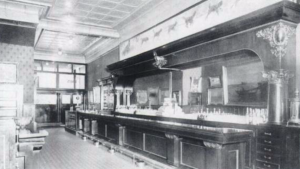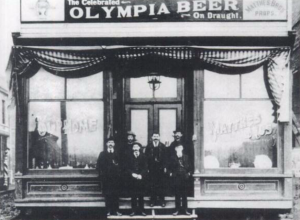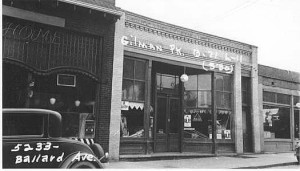It is once again Throwback Thursday and we thought that this week we could have a look at some Ballard bars of yesteryear. Watering holes have been a staple of the Ballard community since the early 1900s so we thought we could pay homage to them in our weekly post.
The bar in the picture below is Ballard Ave’s “Owl Tavern”, which first acquired its liquor license in 1900. According to Julie D. Pheasant-Albright’s book Early Ballard, at one time Ballard Ave had more saloons per square foot of boardwalk anywhere west of Mississippi. Many believe it still does!
According to Pheasant-Albright, one of the most notorious bars “The Brunswick” was owned by the local Mayor Peterson.
When Ballard was annexed to Seattle in 1907, all bars had to reapply for their liquor licenses and pay $1000 to keep them. Bars also had to close at 1 a.m. and on Sundays.
The photo below shows the Ballard Ave spot “Old Home.”
The photo below shows a 1935 black and white photo of the exterior of storefront of a pool hall and bar at 5233 Ballard Ave.
Do you have an historical photo or a story that readers would enjoy hearing about? Email us at tips@myballard.com with Throwback Thursday in the subject line.
Photo and information courtesy of Ballard Historical Society.




More saloons per square foot of boardwalk? Could you find a more obscure manner of trying to say there were a lot of them?
Maybe other towns out West weren’t the muddy shitholes that Ballard was and did not need boardwalks?
It should be noted that the Owl Tavern is what we know today as Conor Byrne!
Ms/Mr. Justice, boardwalks were standard in the US until the advent of Portland cement in the 1880s. I could have said “per square foot of road and business footage”. Ballard’s streets did not have poured cement sidewalks until 1917, and were built under a flurry of protests, as the business owners had to pay for the sidewalks in front of their establishments themselves.
This does seem a bit like explaining gravity to the family dog.
It’s hard to tell, but I’m pretty sure that bar is named “Old Home” rather than “Our Home”.
It was “Old Home”.
Maybe you should’ve said “per square feet of road and business footage” although that is hardly the same as saying “area of boardwalk.”
How many square feet of boardwalk was there?
How much ‘footage’ (sic) did these businesses have?
And lastly, does your book have the same condescending tone you have here?
Thanks!
For the record, that is not a picture of The Owl. Whoever wrote that book was completely miss informed
*misinformed ….damn autocorrect
Justice- lighten up. Your the condescending one here.
Thanks for the cool photos btw.
I did not write this article.
Ms/Mr. Justice, the boardwalks on Ballard Avenue are pretty much the same square footage as the sidewalks that replaced them are today. Feel free to measure.
You stay out of this John. It’s “you’re” as long as I’m putting people in their place.
And Julie, that was exactly the information I was looking for (boardwalk equals sidewalk).
I might measure, as I’m curious how this really compares.
Like many people I need actual numbers. When you said that line in the book, was there any statistical evidence or was that based on anecdotal yarns? (which does not mean it isn’t true)
Wow, Justice, chill out. You are way out of line. Please, Julie, ignore this troll and take the high ground.
OMG – the old MyBallard is back, finally! I love this back-n-forth, reading material during my lunch hour. John, I think you’re up next! Julie – you need to strike back harder!!
Justice, I don’t know what’s going on in your life, but don’t you feel a tad silly picking this particular nit to death? Have you been outside today? It’s the first day of spring, and the sun is shining.
There’s nothing wrong with challenging the claim that Ballard Ave had more saloons than anywhere else west of the Mississippi per unit measure of sidewalk, or whatever.
It’s just another way of saying “there were lot’s of saloons” and trying to make up some statistic to support it. I mean “at one time” is pretty loose, as well as the fact that back at the turn of the previous century, there certainly wasn’t any survey or study regarding how many saloons were on streets all over the country.
It’s kind of like the similar folksy claim that there were more bars than churches in early Ballard, just something that someone said, and others repeated.
Hipster bars back then too? Mustached bar tenders with waist coats serving drinks whose names you’ve never heard before?
Justice sounds like an awful person!
You sound like a piece of work yourself, Troy.
At least my name rhymes with Boy! Yours doesn’t rhyme with anything! Ha!
There is an astonishing amount of information about Ballard if you dig for it. For one thing, Ballard had two newspapers, and those newspapers are available to anyone to look at at the UW and MOHAI. At the time of the merger (really, hostile takeover) with the City of Seattle, Ballard was the 7th largest city in the state of WA. The City of Seattle archives, as well as MOHAI and the UW have some interesting photos of sidewalks actually being built and the streets graded and paved.
In case you are interested in sidewalks, sir, you may be wondering why there are no real sidewalks above 85th. That is because the city limits were 85th.
I have some pretty interesting pictures of Market Street with boardwalks . You can clearly see sand dunes underneath them.
Wooden boardwalks were standard in the West until at least the 1880s, when Portland Cement (named after Portland stone in England, not Portland, OR.) was imported in quantity to the US. The very earliest sidewalks on the west coast were in SF in 1860. (SF at that time was a VERY rich town, because of the gold rush. It had it’s own mint for heaven’s sake.) But to get concrete (which we take for granted,being a very prosaic building material today) to the West Coast was a costly proposition. It had to come by train, or around the Horn (until 1914, when the Panama Canal was built) and was not a big priority in a place with a seemingly endless supply of lumber.
Anything more you would like to know about sidewalks?
There is a persistant myth floating around about the “same amount of bars as churches” in Ballard. This was thoroughly debunked by researchers at the UW, who did a documentary film on the subject. No where in the City of Ballard records was there any such statute. It was a coincidence that at the turn of the century, into the 1920s, there were about the same number of bars and churches. There are still a whole lot of bars and a whole lot of churches, more than any other Seattle neighborhood. (churches, that is, not bars.) Walk around Ballard, and you will see a a lot of small churches that you probably hadn’t noticed before. IF you want exact numbers of bars and churches, year to year, if you care to take the time to check all the Polk directories and City archives and tax records, go ahead. But the UW has already done that for you.
86% of all statistics are just made up right there on the spot!
I made the documentary mentioned above, regarding “a church for every bar.” You can view it online below and find out what we uncovered:
http://www.blackjarfollies.com/ballard/
Feel free to send any questions, comments, etc.
Hello! I recently purchased an antique taxidermy deer mount. It’s from Eugene, Oregon and has the taxidermist stamp and signature from 1924.
The person I purchased this from told me that it was hanging in the Owl Tavern until sometime in the 1960’s at which time her brother acquired it.
I’m looking for old photos of the inside of the Owl Tavern. It would be cool to see the mount hanging in there.
If you have any links or old photos, please share!
Thank you,
-T